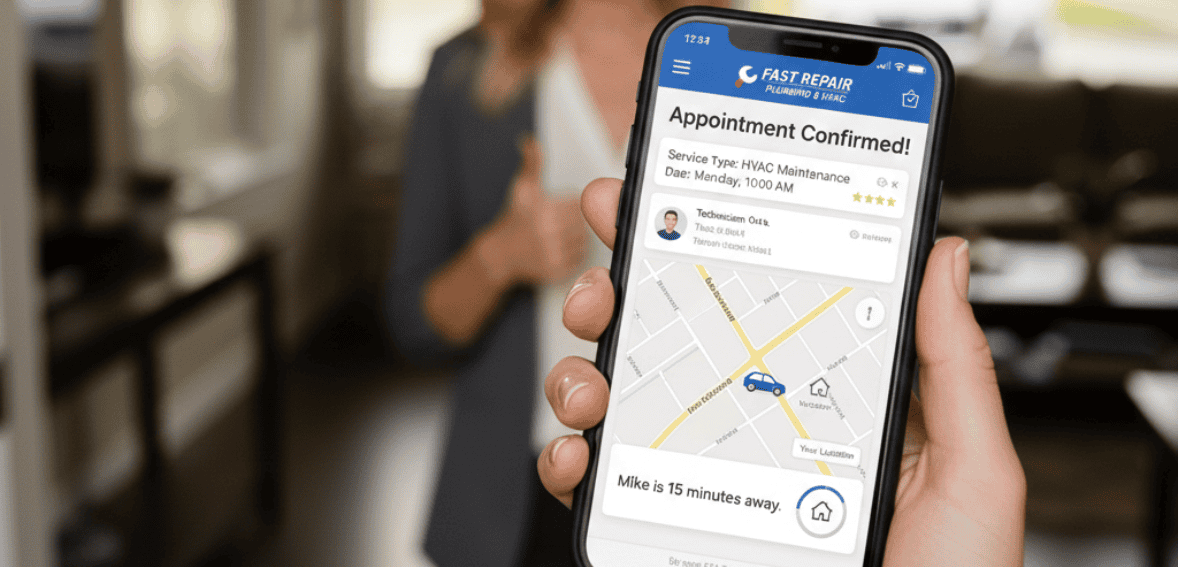
Boosting Customer Satisfaction in Field Service: Strategies for 5 Star Service
In today’s rapidly evolving service landscape, customer expectations have never been higher. The world has shifted into an era where convenience, speed, transparency, and emotional experience shape how customers judge businesses. In field service, especially where interactions happen directly in customers’ homes and workplaces, the quality of service is not just a feature; it’s the foundation of survival and growth. Even the most technically skilled service provider can fall behind if they fail to deliver a smooth and satisfying customer journey. For modern service companies, boosting customer satisfaction is no longer optional; it’s the difference between thriving and disappearing under competitive pressure.
Customers today are used to real-time updates, seamless booking, instant responses, and clear visibility into the service process. They want transparency, not uncertainty; proactive communication, not silence; and professionalism, not chaos. And because reviews and reputation now travel faster than ever, a single poor experience can spread exponentially and affect future business. The companies that win are not the ones performing the most jobs. They are the ones consistently delivering memorable experiences that build trust, loyalty, and long-term relationships.
In field service, a 5-star experience doesn’t come from one big moment; it comes from dozens of small choices and well-executed processes that show customers that their time and trust matter. From first contact to final handshake, the customer journey requires strategy, care, and commitment. This article explores powerful, practical, and human-centered field service customer service strategies to help service businesses build loyalty, drive repeat business, and elevate their reputation.
Table of Contents
ToggleWhy Customer Satisfaction Defines Business Success in Field Service

Field service businesses operate in an environment where competition is fierce, and customer loyalty is fragile. Customers today have more choices than ever, and switching providers is easy, often only one click away. Because of this, a company’s ability to deliver consistently positive experiences becomes one of its most valuable competitive advantages. A satisfied customer can become a long-term partner who trusts your service and continues calling you year after year. A dissatisfied customer may never return and may also discourage others from choosing you.
When customers have a great experience, they feel valued, not just served. They feel confident that they made a wise decision, and that confidence becomes loyalty. Loyal customers bring exponential value: they spend more over time, are less price-sensitive, and refer new customers willingly. In service industries, retention is always more profitable than acquisition. Suppose a business increases customer retention even slightly. In that case, the revenue impact can be tremendous, because happy customers keep coming back and require far less marketing cost than constantly chasing new leads.
Customer satisfaction also strongly influences public reputation. Most service buying decisions today are shaped by online reviews. Prospects want reassurance before they commit, and they trust the experiences of strangers more than vendor promises. High ratings bring more inquiries. Low ratings scare prospects away instantly. In this environment, reputation becomes a currency more powerful than advertising. And the only way to build it is through consistently excellent service.
Simply put, field service customer service is the engine of sustainable growth, not an afterthought. Every job is an opportunity to strengthen, protect, and expand the business.
Fast, Clear, and Transparent Communication

When a customer schedules service, they don’t just want the job done they want certainty and control. Silence creates anxiety, uncertainty creates frustration. Transparent communication is one of the most critical levers for boosting satisfaction. From the moment a customer reaches out, every interaction should reassure them that they are in good hands.
Communication should begin immediately by phone, email, SMS, or a customer portal to confirm the appointment and provide essential details, including time windows, technician identity, preparation steps, and any required materials. Without proactive communication, customers feel ignored or undervalued. But when communication is clear and timely, customers feel respected and informed.
Status updates during the service process greatly enhance trust. For instance, notifying customers when a technician is en route helps them feel prepared and reduces frustration around waiting windows. Real-time updates prevent confusion and eliminate assumptions. Giving customers visibility into technician arrival estimates, progress tracking, and follow-up steps transforms the customer journey into a collaborative experience instead of a disconnected one.
After the service, follow-up messages also matter. A simple check-in asking whether everything went well reinforces the relationship. Customers want to know that they are not forgotten the moment payment is processed. Even small gestures like thanking them for choosing your service or asking how their experience was left a powerful impression. These moments communicate that the relationship matters beyond the transaction.
Ultimately, excellent communication is not about speaking more, it is about reducing uncertainty and increasing clarity. The companies that master this become memorable because they make life easy at every step.
Delivering First Time Fix Success and High Quality Work

One of the strongest drivers of customer satisfaction in field service is resolving issues correctly the first time. Nothing frustrates customers more than multiple appointments, repeat visits for the same issue, or incomplete repairs that disrupt their schedule. When a problem is solved immediately and correctly, customers feel relief, confidence, and gratitude. They associate the service provider with competence, professionalism, and respect for their time.
Achieving high first-time fix rates requires proper planning, technician training, and access to accurate information. Before dispatching a technician, the scheduling team should gather detailed job notes, equipment history, and any relevant service data. A technician should arrive with the right tools, spares and knowledge. If the technician must leave to get parts or reschedule, customers feel disappointed even if the issue wasn’t technically preventable. Perception matters as much as performance.
Empowered technicians also contribute to first-time success. When technicians have access to previous job records, documentation, service manuals, or remote support, they can diagnose and fix problems faster. Training programs and skill development further strengthen this capability. A well-trained field team delivers better experiences, builds customer confidence, and represents the business proudly.
Quality is not only about technical accuracy it also includes how the work is done.
Customers appreciate care, attention to detail, and pride in workmanship. They notice when technicians protect their property, explain steps, answer questions patiently, and check whether anything else needs attention. Quality service is thorough, thoughtful, and consistent.
First-time fix performance is more than a metric; it is one of the most human expressions of respect for a customer’s time and trust. Businesses that master this element stand out immediately.
Real Time Coordination and Communication with Technicians

Behind every smooth customer experience is a strong internal communication system. Customers don’t see the planning that takes place backstage, but they feel its results. When schedules change, traffic delays appear, or emergencies arise, customers depend on seamless coordination between office teams and field technicians. When communication breaks down, customers notice instantly and satisfaction drops.
Real-time internal communication ensures that everyone involved in the service process is aligned. Dispatcher updates should reach technicians immediately, and technicians should have an easy way to report job progress, delays, or required follow-ups. The faster information moves, the quicker decisions can be made, and the smoother the customer experience becomes. Good internal coordination prevents confusion and reduces the likelihood of mistakes, duplicated effort, or lost updates.
Integrating real-time communication also enhances efficiency. When technicians can update job status digitally, office teams gain visibility into workflow and can prepare the next steps without waiting. If a job finishes early, schedules can be rearranged instantly to optimize technician time. If a job requires additional resources, the following steps can be planned without delay. These improvements save time, reduce operational chaos, and help deliver punctual and reliable service.
Customers value punctuality deeply. Being late without explanation can ruin an otherwise excellent job. But when businesses communicate promptly and clearly, even delays can turn into positive experiences. A simple message saying, “Your technician is delayed by 20 minutes due to traffic we apologize and appreciate your patience” shows respect and professionalism.
Behind every 5-star service review is a system built on accuracy, coordination, and transparency. Internal communication might be invisible, but it shapes the most visible parts of the customer experience.
Personalizing the Customer Experience

Every customer wants to feel seen, heard, and understood. In field service, personalization is one of the most potent ways to create loyalty because it transforms routine service into a meaningful connection. Customers do not want to feel like a ticket number in a system they want to feel like an individual whose needs matter. When companies deliver personalized experiences, they show customers that they are valued and essential.
Personalization begins by simply listening. Understanding a customer’s concerns, preferences, and expectations enables service that feels tailored rather than generic. Confirming details such as preferred communication method, special timing requirements, or property access instructions shows respect and consideration. Even small interactions using the customer’s name, remembering details from past appointments, or acknowledging their history build emotional trust.
In field service, personalization also means adapting solutions rather than applying one-size-fits-all answers. Two customers may face the same technical problem, but their context and priorities may differ. A family with small children may prioritize fast resolution; a business owner may prioritize minimizing downtime; an elderly customer may value someone who explains steps patiently and clearly. When technicians understand these distinctions, they deliver experiences that exceed expectations.
Personalization extends beyond the job itself. Following up afterward to check whether everything is still functioning correctly or to offer maintenance advice demonstrates genuine care. Customers remember when a company treats them as more than a transaction. They remember when someone took extra time to reassure them or help them understand. These emotional impressions shape loyalty more than anything.
The truth is simple: people may forget what was done, but they never forget how they felt. Personalization makes customers feel valued, and valued customers stay.
Going the Extra Mile and Practicing Service with Heart

While operational efficiency and technical expertise are essential, the most memorable field service experiences come from small gestures of care. Going the extra mile does not mean expensive perks. It means thoughtfulness, pride, and a genuine desire to help. A clean workspace, a friendly greeting, a calm explanation, and respect for a customer’s home or business environment deeply communicate professionalism.
Customers notice details. They notice when a technician wipes their boots before entering, protects a floor with drop cloths, or carefully cleans up work areas. They notice when someone asks if anything else needs attention or provides helpful tips to prevent future issues. They notice when someone thanks them sincerely for choosing the service. These gestures build trust and appreciation. Trust is the foundation of a lasting customer relationship.
Going the extra mile also means resolving problems fully, not partially. Instead of stopping at the first fix, great technicians look deeper to prevent repeat breakdowns. Instead of rushing out the door, they ensure the customer is comfortable and confident. Instead of ending the conversation at payment, they follow up with support. Customers want reliability, and reliability is born from thorough care.
Empathy is another essential part of extraordinary service. Customers may contact field service providers during inconvenient or stressful moments such as a broken heating system in winter, equipment failure during business hours, or a home problem disrupting daily life. When technicians display calmness, patience, and compassion, customers feel supported rather than overwhelmed. They think someone is on their side.
The companies that excel are not just technically sound; they are emotionally intelligent. They understand that service excellence lives in the small things. The technician who smiles, listens, and takes pride in their work often earns more loyalty than any marketing campaign ever could.
Turning Customer Feedback Into Actionable Improvement

Customer satisfaction is a journey, not a destination. The companies that consistently deliver 5-star experiences continually refine their approach based on feedback. Feedback is a window into real perceptions of what customers love, what frustrates them, and what they wish were different. Instead of avoiding criticism, excellent service companies invite it and use it to grow stronger.
Collecting feedback requires intentional effort. Follow-up surveys after service visits, casual conversations, or even handwritten notes of appreciation all provide crucial information about how customers feel. Encouraging honest responses and making feedback easy to share ensures companies see accurate insights, not just occasional compliments.
Once feedback is collected, the next step is analyzing patterns. If customers frequently mention long response times, unpredictable scheduling, or unclear communication, these become priorities for improvement. If customers repeatedly praise certain technicians, that reveals culture-building strengths. Feedback becomes a roadmap rather than a complaint log.
What matters most is action. When customers see that their comments lead to improvements such as shorter appointment windows, more transparent communication, or training enhancements they feel respected. They feel like partners shaping service quality rather than powerless outsiders waiting for change. Acting on feedback turns complaints into loyalty and turns neutral customers into enthusiastic supporters.
Sharing feedback internally also inspires teamwork and growth. Technicians feel proud when customer praise is acknowledged. They feel motivated when they see how their efforts improve satisfaction. They feel supported when training addresses the challenges they face. A feedback-driven culture becomes a cycle of continuous improvement, stronger communication, better service performance, and more satisfied customers.
The companies that win are the ones that listen carefully to customers and use insights to evolve. Feedback is a gift and when used with purpose, it transforms service from good to exceptional.
Building a Customer First Service Culture

Exceptional customer satisfaction is not achieved through one department or one strategy. It is built through a unified culture where every member of the organization believes that customers are the heartbeat of the business. Culture sets expectations, shapes behaviors, and drives consistency. In field service, where trust and reliability are everything, a customer-first culture becomes a superpower.
A customer-first culture begins with leadership. Leaders must model respect, transparency, and care in every interaction. They must recognize technicians not just for productivity but for service excellence. They must communicate that customer experience matters as much as technical performance. When leaders demonstrate a commitment to service values, the team naturally follows.
Training plays a significant role in shaping culture. Technical training ensures competence, but service training ensures empathy, communication, and professionalism. When technicians understand that their tone, clarity, and demeanor matter as much as the repair, they approach their work differently. They see themselves as brand ambassadors rather than just labor providers.
Collaboration also strengthens culture. When technicians and office staff share the same goal of delivering a smooth customer experience internal teamwork becomes proactive and supportive. Communication becomes open rather than transactional. Everyone operates not as isolated roles but as parts of a single system serving a single mission.
Recognition reinforces culture. Celebrating excellent customer service moments, sharing positive reviews internally, or acknowledging employees who consistently deliver great experiences motivates the entire team. Appreciation strengthens commitment.
A strong culture produces consistency and consistency builds trust. When customers know they can rely on a provider every time, loyalty forms naturally. They choose that business not because there are no alternatives, but because they trust the experience they receive.
In the end, companies with strong cultures grow not just because of strategy, but because people genuinely care about the customers they serve. Culture is the heartbeat behind every 5-star review.
Conclusion
Delivering outstanding field service customer service is about far more than completing technical work. It is about building trust, demonstrating respect for customers’ time, communicating clearly, and providing experiences that feel reliable and valued. When organizations improve how they schedule, communicate, train their teams, act on feedback, and personalize customer interactions, they create a level of service that sets them apart.
In a world where expectations continue to rise and competition grows stronger, the companies that thrive are those that treat every job as an opportunity to build loyalty. They invest in quality, empathy, consistency, and culture. They understand that every interaction can strengthen or damage their reputation. And they create systems that protect customer trust at every step.
A 5-star service experience is no accident. It is choice, strategy and discipline. The more thoughtfully a company serves, the more the business grows, the deeper the relationships become, and the more unforgettable the brand becomes.
Cloud-based job management systems are instrumental in fostering trustworthy operations and enhancing customer experience. By leveraging the transparency and efficiency of cloud management, businesses can build stronger relationships with their clients, ensuring reliable and secure operations. Trustworthy operations are crucial in today’s competitive market, where customer trust directly influences business success.
FAQs
Why is customer satisfaction important in field service businesses?
Customer satisfaction drives repeat business, referrals, reputation, and long-term growth. A satisfied customer returns again and again, while a dissatisfied customer leaves and influences others to avoid the service. Exceptional experiences build loyalty and stability.
How can field service companies improve communication with customers?
By keeping customers informed with appointment confirmations, real-time updates, technician arrival alerts, and follow-up messages, communication becomes transparent and stress-free. Proactive communication builds trust and reduces confusion.
What are the most significant factors influencing customer satisfaction in field service?
First-time fix success, punctuality, professional technician behavior, and clear communication are major drivers. Customers care deeply about respect for their time, property, and peace of mind, not just technical outcomes.
How can companies collect customer feedback effectively?
Simple tools like surveys after service visits, follow-up calls, email check-ins, and casual conversations help gather honest feedback. Using feedback analysis to drive improvement turns insight into action and strengthens loyalty.
What internal practices help companies provide consistently excellent service?
Strong internal communication, continuous training, real-time coordination, and a customer-first culture ensure that service excellence is not random but built into the way the company operates every day.
